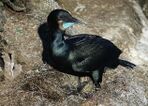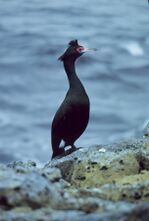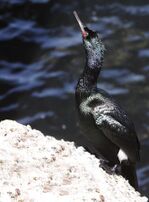Biology:Urile
| Urile | |
|---|---|
| Error creating thumbnail: Unable to save thumbnail to destination | |
| Pelagic cormorant, U. pelagicus | |
| Scientific classification | |
| Domain: | Eukaryota |
| Kingdom: | Animalia |
| Phylum: | Chordata |
| Class: | Aves |
| Order: | Suliformes |
| Family: | Phalacrocoracidae |
| Genus: | Urile Bonaparte, 1856 |
| Type species | |
| Pelecanus urile Gremlin, JF, 1789
| |
| Species | |
|
Urile penicillatus | |
Urile is a genus of birds in the family Phalacrocoracidae, commonly known as North Pacific cormorants. It contains 3 extant and 1 recently extinct species, all of which are or were found in the North Pacific Ocean.
Members of this genus were formerly classified within the genus Phalacrocorax. Based on the results of a molecular phylogenetic study published in 2014,[1] the genus Phalacrocorax was split and these species were moved to the resurrected genus Urile that had been introduced in 1856 by the French naturalist Charles Lucien Bonaparte with the red-faced cormorant as the type species.[2][3][4] Urile is thought to have split from Phalacrocorax 8.9 - 10.3 million years ago.[1] The genus contains four species, of which one is now extinct.[4]
List of species
| Image | Scientific name | Common Name | Distribution |
|---|---|---|---|

|
Urile penicillatus | Brandt's cormorant | Pacific Coast of North America; resident from southern British Columbia south to Baja California, nonbreeding range extends north to Gulf of Alaska and south to Sinaloa |

|
Urile urile | Red-faced cormorant | coastlines of North Pacific Ocean of both Asia and North America, from Hokkaido east to the Gulf of Alaska |

|
Urile pelagicus | Pelagic cormorant | coastlines of North Pacific Ocean of both Asia and North America, breeding range from eastern Russia east to western North America as far south as the Coronado Islands; wintering range extends as far south as Taiwan on the western end of range and central Baja California on the eastern end of range |

|
†Urile perspicillatus | Spectacled cormorant | (formerly) Bering Island, Russia; potentially other islands in the Commander Islands, as well as the parts of the adjacent Kamchatka Peninsula. Now extinct. |
References
- ↑ 1.0 1.1 Kennedy, Martyn; Spencer, Hamish G. (2014). "Classification of the cormorants of the world". Molecular Phylogenetics and Evolution 79: 249–257. doi:10.1016/j.ympev.2014.06.020. PMID 24994028.
- ↑ Bonaparte, Charles Lucien (1856). "Excusion dans les divers Musées d'Allemagne, de Hollande et de Belgique, et tableaux paralléliques de l'ordre des échassiers (suite)" (in French). Comptes Rendus Hebdomadaires des Séances de l'Académie des Sciences 43: 571–579 [574]. https://www.biodiversitylibrary.org/page/1211110.
- ↑ Chesser, R.T.; Billerman, S.M.; Burns, K.J.; Cicero, C.; Dunn, J.L.; Hernández-Baños, B.E.; Kratter, A.W.; Lovette, I.J. et al. (2021). "Sixty-second Supplement to the American Ornithological Society's Check-list of North American Birds". Ornithology 138 (ukab037). doi:10.1093/ornithology/ukab037.
- ↑ 4.0 4.1 Gill, Frank; Donsker, David; Rasmussen, Pamela, eds (August 2022). "Storks, frigatebirds, boobies, darters, cormorants". IOC World Bird List Version 12.2. International Ornithologists' Union. https://www.worldbirdnames.org/bow/storks/.
Wikidata ☰ Q82980656 entry
 |
